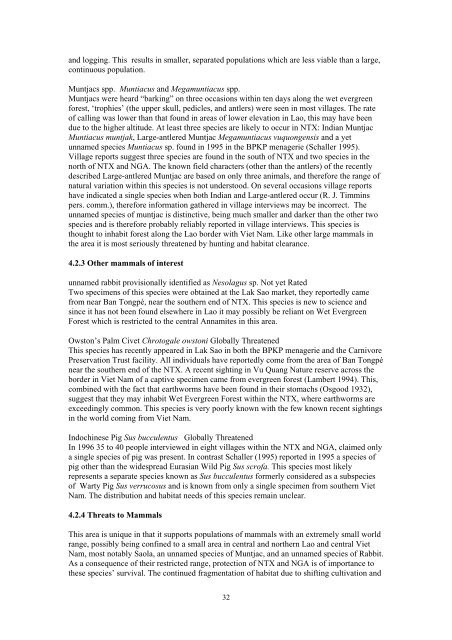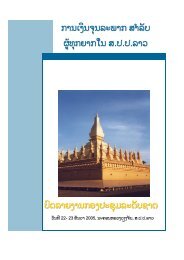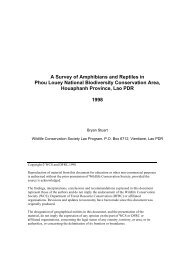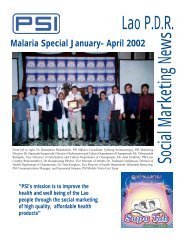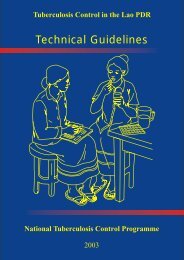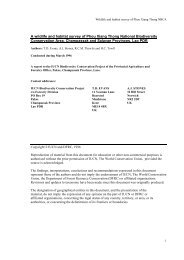A Preliminary Wildlife and Habitat Survey of the Proposed Northern ...
A Preliminary Wildlife and Habitat Survey of the Proposed Northern ...
A Preliminary Wildlife and Habitat Survey of the Proposed Northern ...
Create successful ePaper yourself
Turn your PDF publications into a flip-book with our unique Google optimized e-Paper software.
<strong>and</strong> logging. This results in smaller, separated populations which are less viable than a large,continuous population.Muntjacs spp. Muntiacus <strong>and</strong> Megamuntiacus spp.Muntjacs were heard “barking” on three occasions within ten days along <strong>the</strong> wet evergreenforest, ‘trophies’ (<strong>the</strong> upper skull, pedicles, <strong>and</strong> antlers) were seen in most villages. The rate<strong>of</strong> calling was lower than that found in areas <strong>of</strong> lower elevation in Lao, this may have beendue to <strong>the</strong> higher altitude. At least three species are likely to occur in NTX: Indian MuntjacMuntiacus muntjak, Large-antlered Muntjac Megamuntiacus vuquongensis <strong>and</strong> a yetunnamed species Muntiacus sp. found in 1995 in <strong>the</strong> BPKP menagerie (Schaller 1995).Village reports suggest three species are found in <strong>the</strong> south <strong>of</strong> NTX <strong>and</strong> two species in <strong>the</strong>north <strong>of</strong> NTX <strong>and</strong> NGA. The known field characters (o<strong>the</strong>r than <strong>the</strong> antlers) <strong>of</strong> <strong>the</strong> recentlydescribed Large-antlered Muntjac are based on only three animals, <strong>and</strong> <strong>the</strong>refore <strong>the</strong> range <strong>of</strong>natural variation within this species is not understood. On several occasions village reportshave indicated a single species when both Indian <strong>and</strong> Large-antlered occur (R. J. Timminspers. comm.), <strong>the</strong>refore information ga<strong>the</strong>red in village interviews may be incorrect. Theunnamed species <strong>of</strong> muntjac is distinctive, being much smaller <strong>and</strong> darker than <strong>the</strong> o<strong>the</strong>r twospecies <strong>and</strong> is <strong>the</strong>refore probably reliably reported in village interviews. This species isthought to inhabit forest along <strong>the</strong> Lao border with Viet Nam. Like o<strong>the</strong>r large mammals in<strong>the</strong> area it is most seriously threatened by hunting <strong>and</strong> habitat clearance.4.2.3 O<strong>the</strong>r mammals <strong>of</strong> interestunnamed rabbit provisionally identified as Nesolagus sp. Not yet RatedTwo specimens <strong>of</strong> this species were obtained at <strong>the</strong> Lak Sao market, <strong>the</strong>y reportedly camefrom near Ban Tongpé, near <strong>the</strong> sou<strong>the</strong>rn end <strong>of</strong> NTX. This species is new to science <strong>and</strong>since it has not been found elsewhere in Lao it may possibly be reliant on Wet EvergreenForest which is restricted to <strong>the</strong> central Annamites in this area.Owston’s Palm Civet Chrotogale owstoni Globally ThreatenedThis species has recently appeared in Lak Sao in both <strong>the</strong> BPKP menagerie <strong>and</strong> <strong>the</strong> CarnivorePreservation Trust facility. All individuals have reportedly come from <strong>the</strong> area <strong>of</strong> Ban Tongpénear <strong>the</strong> sou<strong>the</strong>rn end <strong>of</strong> <strong>the</strong> NTX. A recent sighting in Vu Quang Nature reserve across <strong>the</strong>border in Viet Nam <strong>of</strong> a captive specimen came from evergreen forest (Lambert 1994). This,combined with <strong>the</strong> fact that earthworms have been found in <strong>the</strong>ir stomachs (Osgood 1932),suggest that <strong>the</strong>y may inhabit Wet Evergreen Forest within <strong>the</strong> NTX, where earthworms areexceedingly common. This species is very poorly known with <strong>the</strong> few known recent sightingsin <strong>the</strong> world coming from Viet Nam.Indochinese Pig Sus bucculentus Globally ThreatenedIn 1996 35 to 40 people interviewed in eight villages within <strong>the</strong> NTX <strong>and</strong> NGA, claimed onlya single species <strong>of</strong> pig was present. In contrast Schaller (1995) reported in 1995 a species <strong>of</strong>pig o<strong>the</strong>r than <strong>the</strong> widespread Eurasian Wild Pig Sus scr<strong>of</strong>a. This species most likelyrepresents a separate species known as Sus bucculentus formerly considered as a subspecies<strong>of</strong> Warty Pig Sus verrucosus <strong>and</strong> is known from only a single specimen from sou<strong>the</strong>rn VietNam. The distribution <strong>and</strong> habitat needs <strong>of</strong> this species remain unclear.4.2.4 Threats to MammalsThis area is unique in that it supports populations <strong>of</strong> mammals with an extremely small worldrange, possibly being confined to a small area in central <strong>and</strong> nor<strong>the</strong>rn Lao <strong>and</strong> central VietNam, most notably Saola, an unnamed species <strong>of</strong> Muntjac, <strong>and</strong> an unnamed species <strong>of</strong> Rabbit.As a consequence <strong>of</strong> <strong>the</strong>ir restricted range, protection <strong>of</strong> NTX <strong>and</strong> NGA is <strong>of</strong> importance to<strong>the</strong>se species’ survival. The continued fragmentation <strong>of</strong> habitat due to shifting cultivation <strong>and</strong>32


